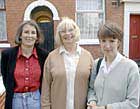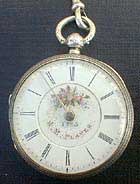

[Chapelfields team]
![]()
the Chapelfields team
 |
The Chapelfields team, left to right: Sheila Browne, Barbara Hollins and Jan Dixon |
Barbara Hollins: Mount Street
Jan Dixon: business analyst, St Thomas White's Street
Sheila Browne: legal executive, Craven Street
The Chapelfields team was given a watch inscribed with the name
'A M PLAYER' and dated 1893; 'CCWMS' is engraved on the back.
They had to find out who 'A M Player' was and where the watch
was made. The three women also wanted to find out more about the
purpose-built estate that was the origins of Chapelfields, how the watches were put together by the various artisans and
how the latter inter-related.
how the team got on

the Chapelfields team watch
HISTORY ROOM
Barbara, Sheila and Jan were given a watch with the name 'A M
Player' on the front and the initials 'CWMS' on the back. They
start by researching into the history of the watch. They try to
link the name with watchmakers listed in trade directories, but
find that there are many 'Players'. They check in the census returns
for 1891 and discover an 'Annie M Player', daughter of a household at No. 33 Mount Street in Chapelfields.
From a trademarks directory, they also find out that 'CCWMS' stands for 'Coventry Co-operative Watch Manufacturing Society' and that, according to an 1894 trade directory, this was based at No. 35 Mount Street. The trade directory, which lists all the trades carried out in a particular locality, gives them a vivid illustration of the division of labour in the watch industry.
Chapelfields was created as a purpose-built watch-making estate. They look at the Corporation records for 1856 to see how the building reflected the organisation of work.
HEARSALL LANE
From here, the team can see the back of Craven Street in Chapelfields.
Over 200 watchmakers and apprentices lived in the area, all carrying
out different stages of the watchmaking process. The team can
see the tradesmen's entrances where the rough works for the watches
would have been delivered
MOUNT STREET, CHAPELFIELDS
From the Ordnance Survey map, the team work out where the Players lived and where the Co-op
was. 'Topshops' were built at the back -- workrooms that got a great deal of
light.
HISTORY ROOM
The team trace the former occupants of Barbara's house in Chapelfields,
which has a topshop, including the person behind the graffiti
scratched on a window: 'Merry spewed on his shirt.' By looking
at apprenticeship records, the freemen's index, house deeds and
directories, they find that an Edward Merry was apprenticed to
jeweller George Rice and his wife Sarah in 1871.